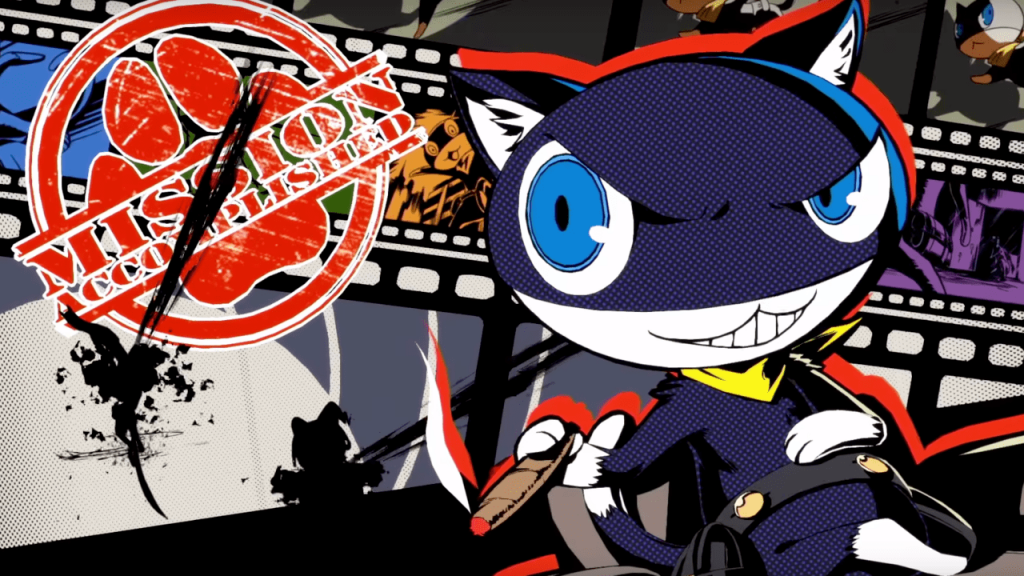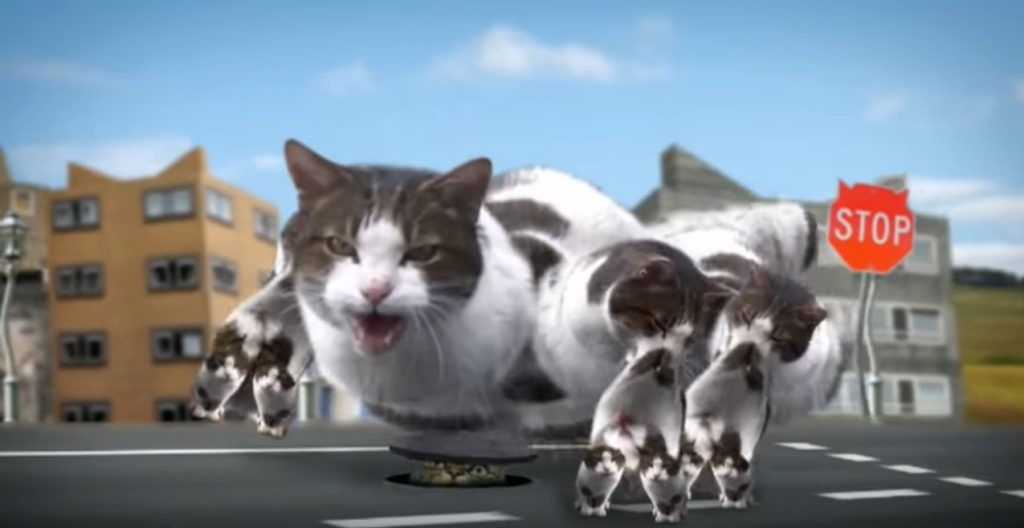In memory of my friend Hannah Frank and her cat Ingeborg
Two decades into the twenty-first century, animated fauna is thriving. A famous nonagenarian mouse with infinite spending power holds the American entertainment market ever more securely in its white-gloved fist (Aguilar 2019). Colorful cartoon ponies have spark(l)ed important debates about contemporary masculinity and fandom (Hautakangas 2015). In 2017, Paddington 2 saved cinema. Most recently, there’s been a goose on the loose, honking its way through the garden of our collective imaginary (Capps 2019).
But if you are looking for a defining moment in the history of animated media, obscure and mainstream alike, cherchez le chat. Long before the recent comic book adaptations boom, Krazy Kat became one of the first comic strip characters to successfully cross over into animation in 1916. Otto Messmer’s silent Felix the Cat series, “the quintessential cartoon of the 1920s,” gave rise to what is arguably the first true animated star (Crafton 1982, 301). Also in the 1920s, Walt Disney and Ub Iwerks’s early work on the Alice Comedies featured a drawn cat character named Julius. Pioneering Japanese animator Noburo Ofuji’s The Black Cat (Kuro Nyago, 1929), produced through chiyogami paper cutout animation, is an example of a “record talkie” (film projected with a synchronized sound on a phonograph record) (Furniss 2016, 159). Originally an experiment in scientific visualization, the 1968 Soviet animation Kitty (Koshechka) is “not only one of the first examples of a film drawn by (as opposed to with) a computer, but one of the first attempts to render realistic animal motion digitally” (Wilson 2013, 4). Ralph Bakshi’s Fritz The Cat (1972) is commonly credited with the dubious honor of being the first animated feature to receive an X rating in the USA.

I wouldn’t even try.
Sanrio’s Hello Kitty is currently the second highest-grossing media franchise of all time, behind Pokémon – which, incidentally, features numerous cat-like and cat-inspired characters, such as Meowth and Mewtwo (Figure 1), to name only a couple (Jones 2019). Cats big and small stalk the landscapes of global animation. Tom and Sylvester remain two of the most enduring icons of the Golden Age of American animation. The Cheshire cat, in all its animated incarnations, has graced the screen for decades, most recently (if not most memorably) in Tim Burton’s visual effects-heavy Alice in Wonderland features. Manga legend Osamu Tezuka’s own feline creation, Kimba the White Lion, crossed over into TV in 1965. The AristoCats (Wolfgang Reitherman, 1970) jazzed up Disney’s catalog, affirming that “Ev’rybody Wants to be a Cat.” Since the launch of Jim Davis’s original cartoon strip in 1978, lazy, gluttonous, infinitely relatable Garfield has starred in several animated television series and live-action/CG movies. The same year, Soviet children fell in love with the talking cat Matroskin who, together with a dog and a little boy, formed the Three from Prostokvashino (Vladimir Popov, 1978-1984). The USSR also gave us two separate animated adaptations of Rudyard Kipling’s story “The Cat That Walked by Himself” – a 1968 short by Alexandra Snezhko-Blotskaya and a 1988 feature by Ideya Garanina.

Studio Ghibli boasts an impressive catalog, including My Neighbor Totoro’s Catbus (Hayao Miyazaki, 1988), witch sidekick Jiji from Kiki’s Delivery Service (Hayao Miyazaki, 1989), and almost the entire cast of The Cat Returns (Hiroyuki Morita, 2002) (Figure 2). Western Europe has contributed a few adult-oriented features to the canon, such as German cat noir Felidae (Michael Schaack, 1994) and French features A Cat in Paris (Jean-Loup Felicioli and Alain Gagnol, 2010) and The Rabbi’s Cat (Joann Sfar and Antoine Delesvaux, 2011). On TV, animated cats occasionally fight crime, as in China’s Black Cat Detective (1984-1987) and the British series Fantcomcat (1995-1996), which features a masked swashbuckling hero. Down under, in the Kitty is Not a Cat (2018 – ) series, a little Australian girl has chosen to live as one of her furry friends…and really, who wouldn’t?

Video games, too, have caught the feline fever. Neko Atsume: Kitty Collector, a mobile game with a self-explanatory title, shook up the casual game scene in 2014. High-concept first-person simulator Catlateral Damage (2015) – which, it should be noted, embraced the joys of channeling a terrible creature a good few years before 2019’s aforementioned viral goose had even had a chance to hatch – allows the player to live out the ultimate dream of knocking objects off countertops with no repercussions. Morgana the cat (Figure 3) is the only non-human fighter in the super-successful Japanese role-playing game Persona 5 (2016). In the poignant, narrative-focused Night in the Woods (2017), anthropomorphized feline protagonist Mae struggles to navigate her past, mend broken relationships, and face the challenges of adulthood. And the future looks just as bright: this summer, developer Eric Blumrich and his team announced that they were working on the indie open-world game Peace Island, which will allow players to “assume the role of mystery-solving cats” (Coulson 2019).
The brief overview provided above is by no means comprehensive. In fact, simply listing an arbitrary selection of animated cats takes up a considerable amount of space: Peg-Leg Pete, PuppyCat, Princess Carolyn, Unikitty, Pink Panther, Postman Pat’s Jess, Penelope Pussycat, Mio and Mao, Top Cat, Polly Esther, Doraemon, Puko, Leopold the Cat, Si and Am, SWAT Kats, Heathcliff, Daniel Tiger, Luna, Chococat, Bananya, Nyanko-sensei, Chi, Simon’s Cat, Ed Catmull. It’s cats all the way down.
The pervasiveness of cats in animated media is no coincidence; after all, it is cats that most fully embody the essence of animation itself. Cats are quintessentially plasmatic beings. They don’t simply move – they flow. A cat cannot be easily contained; it is pure kinesis, flux incarnate. Cats are not beholden to the laws of physics. A falling cat’s body twists and turns in ways that render gravity irrelevant and human vision inadequate. It mocks the conventions of anatomy, pushes against the very fabric of common sense. It will fit where it pleases, and mold itself in ways that defy expectation. Metamorphosis, the life force of animation, is the domain of cats. In William Kentridge’s work, a cat repeatedly turns into a megaphone. This is as it should be; cats are resistance. Sergei Eisenstein knew as much, too; a lion statue sprang to life in Battleship Potemkin (1925), and its roar still echoes.
Cats are fierce and vicious. Cats are chaotic energy. A cat dismembering its kill is stop-motion animation in reverse. Cats are monstrous and grotesque, and undeniably hypnotic – animated experiments in the flesh. Cats were invented by Jan Švankmajer and inherited by the Quay Brothers. In Captain Marvel (Anna Boden and Ryan Fleck, 2019), Goose the cat is cute and cuddly. It is also a tentacled alien beast that can swallow the secrets of the universe. Marvel has gotten much wrong over the years, but not this.

Cats are glitchy. A cat will freeze suddenly or zoom off for no reason. In a manner of seconds, the smoothest motion turns to visual stutter. A cat’s capacity for self-disruption is as erratic as it is boundless; it is no wonder David OReilly’s digital meltdowns often feature cats. In Octocat Adventures (2008), the union between form (cat) and content (disarray) is complete. Cats are walking non-sequiturs, the embodiment of an absurdist derailment of thought and action. Cyriak’s surreal web animation Welcome to Kitty City (2011) may thus be the closest the medium has ever come to capturing the barely contained mayhem that fuels a cat’s existence (Figure 4). In Patrick Buhr’s experimental short What I Forgot to Say (2014), the narrator begins by promising to explain two things: what it means to be a flaneur and how he became a flaneur. Then he interrupts himself: “But first, a cat. Here are a lot of cats meowing”. This makes no sense, even in context. And neither do cats.

Cats can be moody, vindictive, and irrational. If humanity has dreamed of – and through – animated cats for over a century, it is only fitting that its worst nightmares would also come to life because of cats, or more specifically, Cats (Tom Hooper, 2019) (Figure 5). Since the trailer for this mutated offspring of bad intentions and worse CGI dropped a few months back, we as a society have had to face some crucial cultural questions: can an animation technology be objectively evil (yes) and how do we stop it? Was the valley of the shadow of death the uncanny valley all along? And, why was Andy Serkis not invited?
But cats are also perceptive. They learn our weaknesses, and how to exploit them. They have that in common with Disney, as evidenced by the recent release of The Lion King (2019), a regurgitated hairball of half-digested nostalgia. Cinematic zombies have amply demonstrated the dangers of corporeal reanimation for decades now, but it was, once again, (big) cats that illuminated the peril of digital reanimation. Audiences may have wept anew at the circle of life, well-trained creatures that we are, but this soulless, sterile, mercilessly defanged remake serves as a reminder that not everyone should be granted nine lives.
Cats can teach us things – about ourselves, and about art. Experimental artist Carolee Schneemann wrote the following about cats:
“I’m blessed with muse-cats who have inspired and guided my work. The lessons include: improvisation in space with found materials […] and the transitions between visible and invisible; they have clarified the motion between domestic worlds and a scale of landscape inaccessible to humans; they have enlarged and shifted my scale of perceptions” (Goodeve 2015).
Indeed, above all, cats are here to disrupt the status quo. On https://omgcatrevolution.tumblr.com/, a blog she co-curated with Whitney Strub, Hannah Frank wrote that “a cat is never on the side of power.” It is always, I would add, on the side of animation.
References
Aguilar, Carlos. 2019. “Chart: Everything that Disney Owns.” Cartoon Brew, April 2. https://www.cartoonbrew.com/disney/chart-every-company-that-disney-owns-172130.html
Capps, Kriston. 2019. “The Viral Video Game Where You Play a Horrible Goose.” The Atlantic, October 5. https://www.theatlantic.com/entertainment/archive/2019/10/untitled-goose-game/599452/
Coulson, Josh. 2019. “Peace Island is the New Game that Lets Players Assume The Role of a Crime-Solving Cat.” The Gamer, July 25. https://www.thegamer.com/peace-island-new-game-lets-players-assume-role-crime-solving-cat/
Crafton, Donald. 1982. Before Mickey: The Animated Film 1898-1928. The University of Chicago Press.
Furniss, Maureen. 2016. A New History of Animation. New York: Thames & Hudson.
Goodeve, Thyrza Nichols. 2015. “’The Cat is my Medium: Notes on the Writing and Art of Carolee Schneemann.” Art Journal Open, July 25. http://artjournal.collegeart.org/?p=6381
Hautakangas, Mikko. 2015. “It’s OK to be Joyful? My Little Pony and Brony Masculinity.” The Journal of Popular Television 3 (1): 111-118.
Jones, Mike. 2019. “Hello Kitty Movie in the Works at New Line Cinema.” Screen Rant, March 5. https://screenrant.com/hello-kitty-movie-new-line-cinema/
Wilson, Booth. 2013. “Computer Animation Across the Iron Curtain: Early Digital Character Design in Kitty.” Animation Journal 21: 4-25.
Mihaela Mihailova is a Postdoctoral Fellow at the University of Michigan Society of Fellows. She has published in animation: an interdisciplinary journal, Studies in Russian and Soviet Cinema, Post Script: Essays in Film and the Humanities, and Kino Kultura. She has also contributed chapters to Animating Film Theory (with John MacKay), Animated Landscapes: History, Form, and Function, The Animation Studies Reader, and Drawn from Life: Issues and Themes in Animated Documentary Cinema.

3D, Vfx animation services
this is a great inspiration for me as an animator it’s give me boost to do more creativity in my work